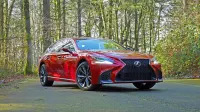Did Lexus make a BMW? Or did BMW make a Lexus? This and other 2017 surprises

Most were pleasant surprises, but there were a few head scratchers and facepalms for good measure. In both cases, it was generally the result of car companies seemingly trying to break out of an existing mold.
Nowhere was that more apparent than the pair of Lexuses slathered in Infrared paint: The LS 500 that left me this week and the LC 500 that was my favorite car of 2017. Though Lexus has been trying to shake its crusty, gold-packaged reputation for some time now, its efforts always seemed like an old man choosing Hollister to redo his wardrobe after realizing it hasn’t been updated since 1987.
I fell in love with the LC, genuinely floored by its near-perfect take on the GT. It’s characterful in sound, appearance and tactility. It was at home in the city, in the mountain and on the open road. It was both comfortable and thrilling, and after driving the mechanically related LS 500, I can report that the LC’s talents aren’t an outlier.
The LS 500’s turbo V6 may make different noises than the LC’s naturally aspirated V8, but it nevertheless invigorates the cabin when the car is placed in Sport+ mode. The steering is truly communicative, body motions are kept in miraculous check, and I absolutely forgot I was in an enormous luxury limo … and a Lexus one at that.
It was everything that the BMW 530e was not. I drove that on the exact same roads and was utterly bored the entire time. Generally doughy, lifeless steering, more distant than Planet 9. And no, the plug-in hybrid powertrain had nothing to do with that. At least it shouldn’t. The Porsche Panamera S e-Hybrid I also drove this year proves that, as do the Hyundai Ioniqs, which are surprisingly adept and fun little cars regardless of what powers their wheels (Hyundai + hybrid = fun really blew me away).
I would drive that Lexus LS F Sport over the BMW 5 Series any day of the week, which seems like a shocking thing to say in relation to either car. While Lexus is seemingly breaking out of its old crusty mold, BMW seems to be climbing into one. And no, I’m unimpressed by ever-increasing horsepower and ever-decreasing 0-60 times.
Now, while BMW made a stinker, Kia made a Stinger. Vehicle dynamics have long been the missing piece in Kia’s “Build a Great Car” puzzle, and the Stinger shows the company may have finally found it — or at least be on the right track. I’m guessing that the mechanically related Genesis G70 will make a similar impression in 2018.
On the other hand, the Kia Optima Hybrid was without question the dullest car I drove this year. It was even beige. Which certainly goes to show the folly of having expectations based on brand. The new LC and LS were countered by the utterly confounding GX 460. Quite oppositely, the Toyota 4Runner that endeared itself by being refreshingly old school was followed up by the decidedly new-school C-HR: a “crossover” that doesn’t offer all-wheel drive, has less ground clearance than a Corolla and provides the outward visibility of Keaton’s Batmobile. At least it handled well.
In non-Toyota-related observations, the Lincoln Navigator’s mid-century-tastic interior wowed while I found the Continental’s backseat to be surprisingly cramped and its ride unrefined. I was pleasantly surprised by the new Volkswagen Atlas (it has size, solidity and long-distance comfort to spare) and underwhelmed by the e-Golf (the Ioniq is a superior electric car). Oh, and the Nissan Rogue Sport is shockingly dynamic compared to its oafish non-Sport sibling. That’s probably a back-handed compliment.
Oh well, here’s to more surprises in 2018. Well, automotive ones at least.
Related Video:




